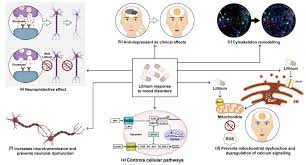Action Steps for a Positive Mood Transformation: Treatment with Pills
Přidal minyunhee11, dne 9. 01. 2025, 0x

Introduction
Mood disorders, such as depression, anxiety, and bipolar disorder, can profoundly impact an individual's quality of life. However, with the right action steps and treatment plans, including medication, individuals can transform their mood and regain emotional balance. This guide outlines a comprehensive plan to achieve a positive mood transformation using pills as part of the treatment approach.
Understanding Mood Disorders
Mood disorders stem from an imbalance of neurotransmitters like serotonin, dopamine, and norepinephrine in the brain. These chemical messengers regulate emotions, energy levels, and overall mental well-being. When their levels become unbalanced, individuals may experience:
Persistent sadness or irritability
Loss of interest in activities
Sleep disturbances
Low energy or fatigue
Difficulty concentrating
Medication plays a crucial role in restoring balance to these neurotransmitters, creating a foundation for improved mental health.
Action Step 1: Seek Professional Guidance
The first and most critical step is consulting a healthcare provider. A psychiatrist or physician will assess your symptoms, medical history, and lifestyle factors to determine the appropriate medication. Commonly prescribed categories include:
Antidepressants: For treating depression and anxiety disorders
Mood Stabilizers: For managing bipolar disorder
Anti-anxiety Medications: For reducing acute anxiety
Atypical Antipsychotics: Sometimes used to enhance mood stabilization
Why Professional Guidance Matters
Self-medication is dangerous and ineffective. Only a licensed medical professional can determine which medication suits your unique needs.
Action Step 2: Understand Your Medication Options
1. Selective Serotonin Reuptake Inhibitors (SSRIs)
SSRIs increase serotonin levels in the brain, promoting feelings of well-being. Popular SSRIs include:
Fluoxetine (Prozac)
Sertraline (Zoloft)
Escitalopram (Lexapro)
2. Serotonin-Norepinephrine Reuptake Inhibitors (SNRIs)
SNRIs boost serotonin and norepinephrine levels, enhancing mood and energy. Examples include:
Venlafaxine (Effexor)
Duloxetine (Cymbalta)
3. Tricyclic Antidepressants (TCAs)
Although older, TCAs remain effective for severe depression. Options include:
Amitriptyline
Nortriptyline
4. Benzodiazepines
For immediate relief from anxiety or panic attacks, benzodiazepines like lorazepam (Ativan) or alprazolam (Xanax) are prescribed, although only for short-term use.
5. Mood Stabilizers
Lithium and anticonvulsants like valproate (Depakote) help regulate mood swings in bipolar disorder.
6. Atypical Antipsychotics
Medications such as aripiprazole (Abilify) or quetiapine (Seroquel) can enhance the effectiveness of antidepressants.
Action Step 3: Follow Prescribed Dosages
Adhering to the prescribed dosage is critical for achieving the desired results. Common mistakes, such as skipping doses or stopping medication abruptly, can lead to:
Worsening symptoms
Withdrawal effects
Increased risk of relapse
Tips for Consistency
Set a Schedule: Take pills at the same time daily.
Use Reminders: Utilize alarms or pill organizers.
Communicate with Your Doctor: Report any side effects promptly.
Action Step 4: Monitor Progress
Mood transformation takes time. Most medications require 4–6 weeks to show full effects. To track progress:
Keep a Mood Journal: Record daily emotions, energy levels, and side effects.
Regular Check-Ins: Schedule follow-up appointments with your doctor.
Adjust Treatment if Necessary: Based on your progress, your doctor may modify the dosage or switch medications.
Action Step 5: Combine Medication with Lifestyle Changes
While pills are a powerful tool, integrating them with healthy habits accelerates mood improvement. Key lifestyle changes include:
1. Healthy Diet
Consume foods rich in omega-3 fatty acids, magnesium, and B vitamins to support brain function. Examples include:
Fatty fish
Leafy greens
Whole grains
2. Regular Exercise
Physical activity releases endorphins, which naturally elevate mood. Aim for at least 30 minutes of moderate exercise five days a week.
3. Adequate Sleep
Establish a regular sleep schedule to allow your brain to recover and maintain emotional balance.
4. Stress Management
Practice relaxation techniques like deep breathing, meditation, or yoga to reduce stress.
Action Step 6: Build a Support System
Social connections play a vital role in mental health. Surround yourself with supportive friends, family, or a therapist. Joining a support group can also provide encouragement and shared experiences.
Action Step 7: Address Stigma
Despite advances in mental health awareness, stigma around medication persists. To combat this:
Educate yourself and others about the benefits of medication.
Share your journey with trusted individuals.
Remember that seeking help is a sign of strength, not weakness.
Action Step 8: Be Patient and Persistent
Mood transformation is a gradual process. While setbacks may occur, staying committed to your treatment plan ensures long-term progress.
Conclusion
Achieving a positive mood transformation is possible with the right action steps. Medication, when used correctly and under professional supervision, offers a solid foundation for mental health improvement. By combining pills with healthy habits, a supportive network, and a proactive mindset, individuals can regain control of their emotions and lead fulfilling lives.
Start your journey today—your brighter future awaits!










Komentáře:
Nenacházejí se zatím žádné relace v databázi.